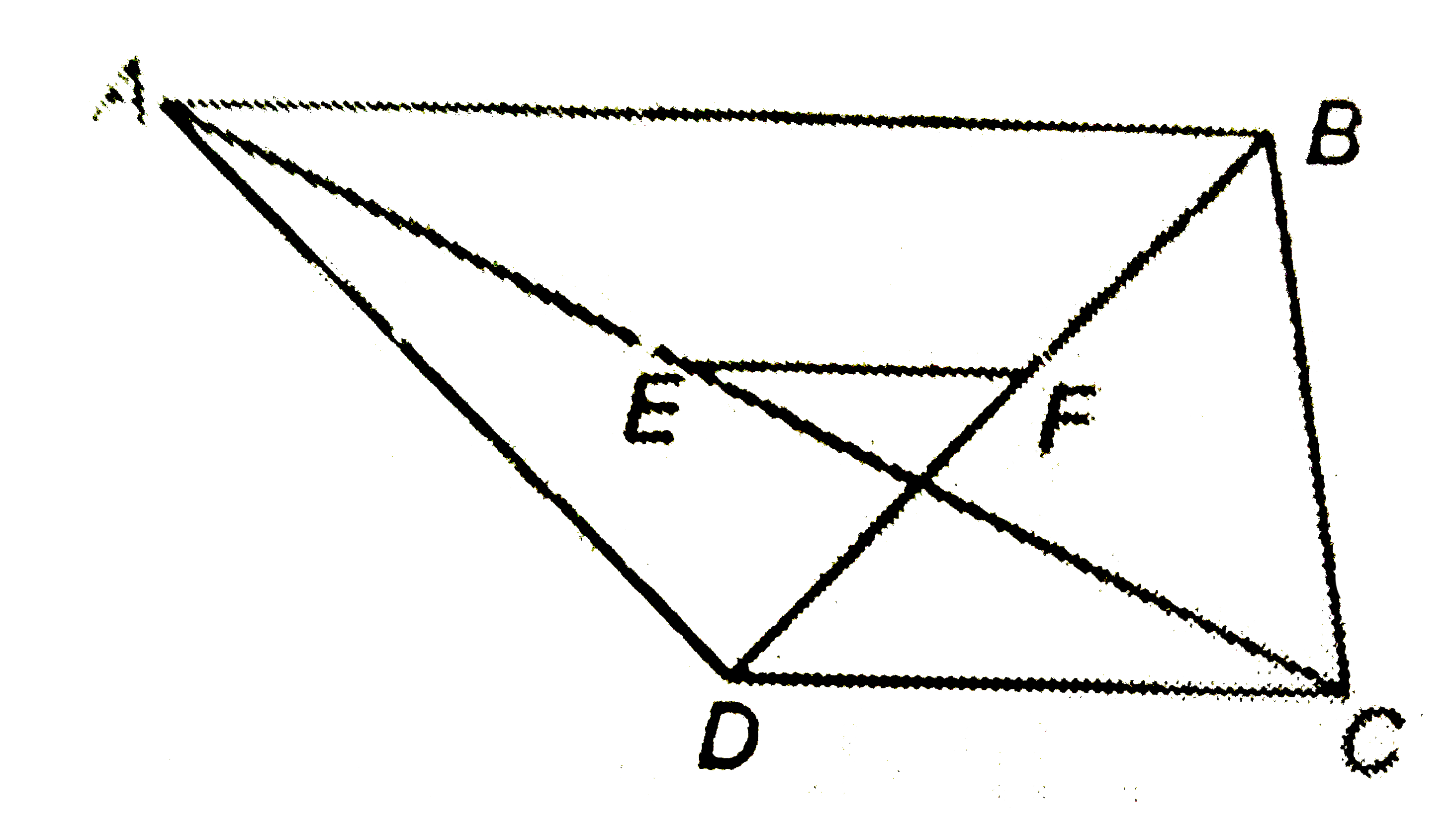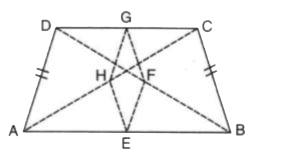ABCD is a trapezium with AB || DC. E and F are points on non-parallel sides AD and BC respectively such that EF is parallel to AB. Show thatAEED=BFFC.
To prove that AEED=BFFC in trapezium ABCD where AB∥DC and EF∥AB, we can follow these steps:
1. Identify the Trapezium and Points:
- We have trapezium ABCD with AB∥DC.
- Points E and F are on sides AD and BC respectively, such that EF∥AB.
2. Apply the Basic Proportionality Theorem:
- According to the Basic Proportionality Theorem (also known as Thales' theorem), if a line is drawn parallel to one side of a triangle, it divides the other two sides proportionally.
- Since EF∥AB, we can apply this theorem in triangle ABD and triangle CDB.
3. In Triangle ABD:
- Since EF∥AB, we can write:
AEED=AFFB(1)
4. In Triangle CDB:
- Similarly, since EF∥AB, we can write:
BFFC=AGGD(2)
5. Relate the Two Ratios:
- From equation (1), we have:
AEED=AFFB
- From equation (2), we can express BF in terms of FC:
BFFC=AGGD
6. Cross-Multiplying:
- From the two equations, we can cross-multiply:
AE⋅FC=ED⋅BF
7. Conclude the Proof:
- Rearranging gives us:
AEED=BFFC
- Thus, we have shown that AEED=BFFC.
- We have trapezium ABCD with AB∥DC.
- Points E and F are on sides AD and BC respectively, such that EF∥AB.
- According to the Basic Proportionality Theorem (also known as Thales' theorem), if a line is drawn parallel to one side of a triangle, it divides the other two sides proportionally.
- Since EF∥AB, we can apply this theorem in triangle ABD and triangle CDB.
- Since EF∥AB, we can write:
AEED=AFFB(1)
- Similarly, since EF∥AB, we can write:
BFFC=AGGD(2)
- From equation (1), we have:
AEED=AFFB
- From equation (2), we can express BF in terms of FC:
BFFC=AGGD
- From the two equations, we can cross-multiply:
AE⋅FC=ED⋅BF
- Rearranging gives us:
AEED=BFFC
- Thus, we have shown that AEED=BFFC.
Similar Questions
ABCD is a trapezium with parallel sides AB=a and DC=b. If E and F are mid-points of non-parallel sides AD and BC respectively, then the ratio of areas of quadrilaterals ABFE and EFCD is: a:b (b) (a+3b):(3a+b) (3a+b):(a+3b) (d) (3a+b):(3a+b)
View SolutionIn ΔABC,AB=AC.D,Eand F are mid-points of the sides BC, CA and AB respectively . Show that :
AD is perpendicular to EF.
View SolutionIn a trapezium ABCD, if E and F be the mid-points of diagonal AC and BD respectively. Prove that EF=12(AB−CD).

View SolutionIf D,EandF are three points on the sides BC,CAandAB, respectively, of a triangle ABC show that the BDCD=CEAE=AFBF=−1
View SolutionIn triangle ABC, angle B is obtuse. D and E are mid-points of sides AB and BC respectively and F is a point on side AC such that EF is parallel to AB. Show that BEFD is a parallelogram.
View SolutionABCD is a trapezium in which AB||DC and P,Q are points on AD and BC respectively, such that PQ||DC, if PD=18 cm, BQ=35 cm and QC=15 cm. Find AD.
View SolutionIn ΔABC,AB=AC.D,Eand F are mid-points of the sides BC, CA and AB respectively . Show that :
AD and FE bisect each other.
View SolutionIf a line intersects sides AB and AC of a ΔABCat D and E respectively and is parallel to BC, prove that ADAB=AEAC
View SolutionD, E and F are the mid-points of the sides BC, CA and AB respectively of triangle ABC. Prove that:
BDEF is a parallelogram.
View SolutionABCD is a quadrilateral in which AD = BC. E, F, G and H are the mid-points of AB, BD, CD and AC respectively. Prove that EFGH is a rhombus.

View Solution
